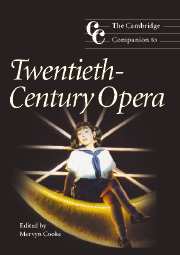6 - Expression and construction: the stage works of Schoenberg and Berg
from Part two - Trends
Published online by Cambridge University Press: 28 September 2011
Summary
To attempt to site the stage works of the Second Viennese School in relation to more encompassing artistic tendencies within opera since 1900 is to come face to face with a number of apparent incongruities. For example, of the six scores which reached a definitive form, only two or three of them – Alban Berg's Wozzeck and Lulu, and perhaps Arnold Schoenberg's Moses und Aron – could be said to have achieved a secure place in the international repertory. Furthermore, if totalitarian censorship, much less perceived considerations of linguistic complexity, has failed to exert any lastingly adverse affect on the canonical status of these compositions, then the further critical veneration of Schoenberg's Erwartung, reverently anticipated by Anton von Webern over a decade before the work's delayed first performance in 1924 (see Webern 1912), does not alter the fact that they remain the legacy of Schoenberg and Berg only. While Berg's 1929 lecture on Wozzeck identified the work as the first full-scale opera to have emerged from ‘the movement that people quite wrongly called atonality’ (Jarman 1989a, 154), it could hardly have been expected to predict two further historical outcomes: that of the two major stage works of the 1930s, one (Moses) would remain a two-act fragment, while the other (Lulu), requiring partial completion of just 87 bars, would have to wait more that four decades for its intended three-act performance.
- Type
- Chapter
- Information
- The Cambridge Companion to Twentieth-Century Opera , pp. 85 - 104Publisher: Cambridge University PressPrint publication year: 2005



